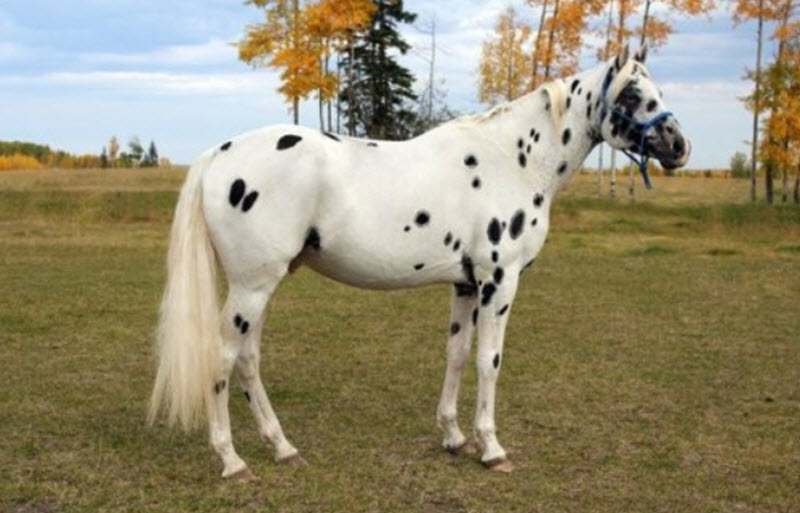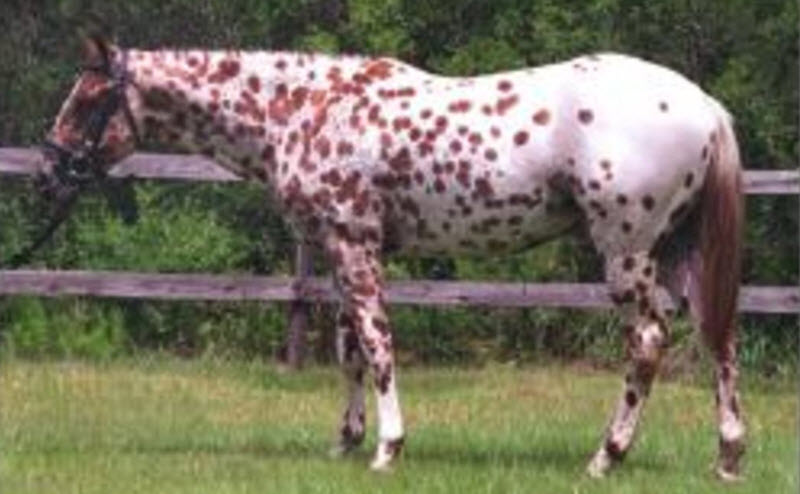On this page:
The horse breed Colorado Ranger was developed on the Colorado High Plains in the United States. It is a great breed for working with cows on a ranch. The Colorado Ranger has great stamina and athletic ability, and many individuals know almost instinctively how to behave themselves around cows.

The breed descends from two stallions that arrived to the United States as a gift from the Turkish Sultan to the U.S. President in 1878. These two stallions were bred to various ranch horses in Colorado and Nebraska. In the early 20th century, the two foals Patches #1 and Max #2 were born – and every registered Colorado Ranger can trace its ancestry back to one or both of them.
Today, the Colorado Ranger is still chiefly found on the Colorado High Plains, but the breed has also become quite popular in the Midwest and Eastern parts of the United States, including Michigan and Pennsylvania. There is also at least one breeding farm for Colorado Rangers located in Canada.
Colorado Rangers are still mainly used for their original purpose, i.e. as ranch horses working with cattle. Some compete in Western and English disciplines (chiefly the former), and Colorado Rangers are also a suitable choice for pleasure riding, including trail riding.
Breed organization
The breed standard is maintained by the Colorado Ranger Horse Association, founded by Mike Ruby in 1935.
Originally, the association only permitted 50 members and only members could register their horse with the association. This resulted in many horses of Colorado Ranger ancestry being registered as Appaloosas instead. This limit is no longer in place.
Dual registration with both the Colorado Ranger Horse Association and the Appaloosa Horse Club is permitted, and roughly 90% of the registered Colorado Rangers of today are registered appaloosas as well. (Appaloosas can not be registered with the CRHA unless they have the required bloodlines.)
Important:
- In most situations, a registered Colorado Ranger can be bred to a registered horse of any of five approved breeds and still have the offspring registered as purebred Colorado Ranger. The five approved breeds are Appaloosa, Ara Appaloosa, Thoroughbred, Arabian, and American Quarter Horse.
- Horses with draft horse or pony blood may not be registered with the CRHA.
- A horse can not be registered with the CRHA if there is Pinto or American Paint Horse breeding within five generations of the horse’s pedigree.
Characteristics
Color
A Colorado Ranger may be of any solid color or display a leopard spotting pattern. Important: Pinto coloration and American Paint Horse coloration are not allowed.
Height
14.2 to 16 hands.
Body type
- Straight facial profile
- Long and muscular neck
- Deep chest
- Sloping shoulders and croup
- Short back
History

The stallions Linden Tree and Leopard
In 1878, the US president Ulysses S. Grant was gifted two stallions by the Turkish Sultan Abdul Hamid II.
- A gray Berber horse (Barb horse) named Linden Tree, foaled in 1874. The Berber horse is a north African breed known for its hardiness, stamina and fiery temperament.
- A gray desert-bred Arabian horse named Leopard, foaled in 1873.
Linden Tree and Leopard first arrived to Virginia, where they lived for many years with Randolph Huntington’s breeding herds. In 1896, Huntington leased them to General Colby, who was a friend of Ulysses S. Grant. Colby bred the stallions with several mares on his ranch in Nebraska, and the matings yielded exceptionally good ranch horses. Other ranchers took notice of Colby’s horses, and a group of ranchers with land in Colorado joined forces to buy a group of horses from Colby. This group consisted of several mares and one stallion. All the mares were sired by one of the two Turkish stallions, and the stallion – a few-spot leopard Appaloosa – was a grandson of Leopard on both sides of his pedigree.
The group of horses bought from Colby were used to improve the ranch stock in Colorado, thus creating the Colorado Ranger breed.
The stallions Max and Spotte
Max and Spotte were two stallions who became important sires for the Colorado Ranger breed.
- Max was a leopard-spot colt born in Colorado in 1918.
- Spotte was a Berber horse (Barb horse) imported from North Africa to the United States by the W.R. Thompson Cattle Company in 1918. (The owner of the company imported the horse as a wedding gift for his daughter.) Spotte provided the Colorado Ranger breed with an important infusion of Berber horse genetics, as Linden Tree’s contribution had become rather diluted at this point.
Mr Mike Ruby, Patches & Max
An essential person in the history of the Colorado Ranger breed is the horseman Mike Ruby from the Colorado High Plains. He owned many horses, including Patches #1 and Max #2 – two important foundation sires for the Colorado Rangers breed.
During the severe Dust Bowl droughts of the 1930s, Ruby helped save the lives of several high-quality Colorado Ranger horses by driving them over 300 miles to a place where they could have access to sufficient pasture. When the prolonged drought finally ended, Ruby drove the horses back to their original pasture in Colorado.
After the Dust Bowl era, Ruby re-established his breeding herd and also helped grow the breed by leasing groups of his horses to other ranchers in the Western United states who wished to use them for breeding. In addition to being bred with each other, the Colorado Rangers received genetic material from several western stock horse breed, including Appaloosa and Quarter Horse.
CRHA
Mike Ruby always kept detailed records of his breeding projects, and when he eventually founded the Colorado Ranger Horse Association (CRHA) in 1935, his records became the initial pedigree record. Ruby remained president of the association until his death in 1942.
Until 1964, the CRHA never allowed more than 50 members, and only members were allowed to register their horses. This meant that a lot of horses of the right Colorado Ranger ancestry were registered with the Appaloosa Horse Club instead.
Since the limit was abolished, the association has been carrying out pedigree research to find horses that qualify for registration with the CRHA. By 2005, the numbers had been bumped up to over 6,000 registered Colorado Rangers.
Lusitano input
In the 1980s, the CRHA allowed some Lusitano genetic material into the Colorado Ranger breed. This is no longer permitted.
The Lusitano is a Portuguese horse breed, closely related to the Andalusian horse breed.
